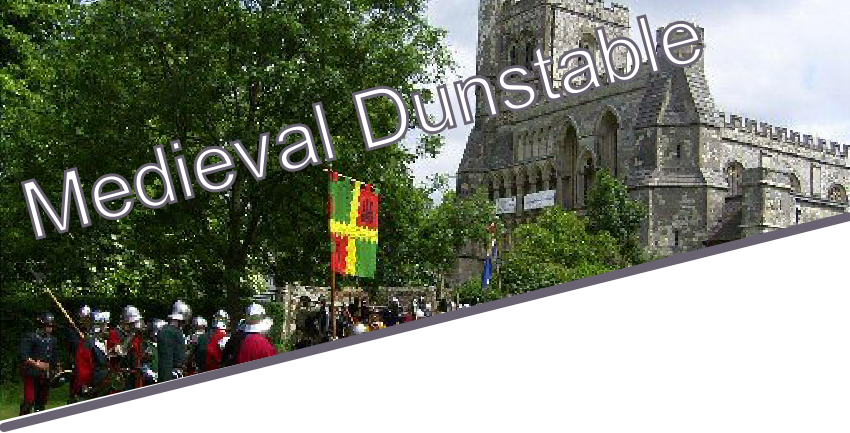
Medieval Dunstable© Webmaster Helen Mortimer Privacy Policy | Terms of Use



Medieval Dunstable - Time Line 1100 - 1550
Author Jean Yates
1086
No mention of Dunstable in the Domesday Book. Notes say Dunstable was a deserted Roman ruin, not yet resettled, but the figures for Houghton Regis perhaps make more sense if villagers were trading at crossroads at that time, to which the sheriff turned a blind eye, but increased their taxes.
1095
First Crusade, Pope Urban II calls the Knights of Christendom to liberate Jerusalem from Muslims
1099
Christian Knights capture Jerusalem, Knights Templar and Knights Hospitallers founded, (1)
1100
Henry I ascended the throne, fourth son of William the Conqueror, he reigned for 35 years.
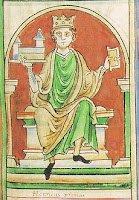
Henry I - 1100-1135
1100
Onwards, kings use paid soldiers as well as knights performing feudal service. They accept ‘scutage’, (payment), in lieu of feudal military service, and use the money to pay soldiers. (1)
C1107
Henry I planted a business centre at the crossroads. He invited free burgesses from elsewhere to settle on crossroads with the freedoms enjoyed by burgesses in London.
1108
The church of the Holy Trinity with in Aldgate, London, was founded in 1108 by Queen Maud. Aldgate’s charter was signed at Dunstable. (The Cartulary of Holy Trinity) Dunstable was a daughter house.
1109
Henry I stayed a night in Dunstable (Farrer) to monitor progress of town. Kingsbury palace up and running on a site of 9 acres, in the area of today’s Old Palace Lodge Hotel. Tournaments held here (recorded at a later date) in a forecourt between Kingsbury buildings and East(Church) Street.
C1110
Miracle play of St. Katherine, mention of a school. – this is a very early mention of a play and a school. Perhaps first recorded performance of public play. Education rested in the hands of the religious institutions at this time. The school formed part of the 1131 endowment to the Priory
1122
Henry I stayed at Kingsbury for Christmas and messengers from Count of Anjou visited him.
1123
According to Roger of Wendover, Henry I at Dunstable and noted bad roads and 'robbers'.
1125
Bernard, Prior of Dunstable, is a witness to a document of Aldgate dated 1125 (2)
1131
Henry I handed over the organisation and control of his royal town and international market to the Augustinian canons who he had invited to build a Priory in Dunstable. Much opposition from burgesses.
1131
Henry I gave the town its first charter. Henry stayed at Kingsbury, King Henry I says in his charter ‘the church …. I have founded’, the foundation of Dunstable took place before 1131.
1131
Morinus de Pinu ‘gave the land at Catebi’ (Cadeby). Cadeby Village Book
1131/2
Henry I spends the Christmas season at Dunstable
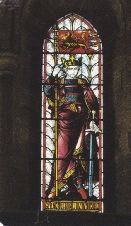
King Stephen 1135-1154
1135
Stephen ascended the throne, and reigned for 19 years.
1137
King Stephen spends Christmas at Dunstable
1154
King Stephen and the future Henry II met briefly in Dunstable
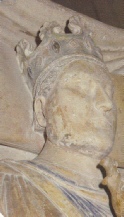
Henry II 1154-1189
1154
Henry II, the first of 14 Plantagenet kings ascended the throne. He reigned for 35 years.
1189
Richard I, Coeur-de-Lion, ascended the throne and reigned for 10 years.
1194
King Richard I introduces a licensing system under which tournaments can legally be held in England, defying a Papal ban in 1130. (1)
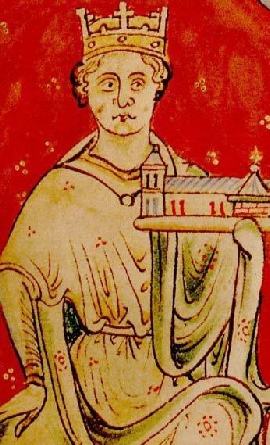
King John 1199 - 1216
1199
John ascended the throne and reigned for 17 years.
1202
Richard de Morins appointed Prior, he was an important man, appointed by King John and had been a Papal Legate. He begins to write the Annals of Dunstable. They are nationally and internationally important. Morins also founded the hostel, almonry and leper hospital, i.e. he provided for all types of travellers. The Augustinians were the medieval social services providers, unable to charge, they needed and accepted gifts of money and land.
1202-1204
IVth crusade attacks Zara (Hungary) and Constantinople.(1)
1203
The king confirmed a gift to us of a three days market
1204
The king confirmed a gift to us of his houses and garden at Dunstable. King John gave Kingsbury palace to the Prior. The Prior rented Kingsbury out to businessmen and later King Edward had it repaired for a tournament. New apartments for the king were built at the Priory where visiting Royals could stay.
1205
Bones of St. Fremund translated from Cropredy in Oxfordshire to Dunstable. – King John had a hand in giving us these. St Fremund feast day May 11th.
1205
Sir Gaufridus le Cauceis grants the church of Bradeburn’ (Derbyshire) with its chapels etc., for the support of the hospice at Dunstable, because they are placed on a public crossroads of England, they have very many guests; it is seemly therefore that at God’s prompting they should have some helpers in satisfying so many. Charters of the Priory (4)
1202-17
Simon of Pattishall received land from the Prior of Dunstable, in return for which he was ‘to find for the prior fitting entertainment (lodgings), three times a year, if he comes with four horses, or twice a year if he comes with six horses’. (The canons route to Derbyshire) (4)
1208
The Priory of St Peter started a hospital of St Mary Magdalene (HER 154) for lepers in 1208 on the east side of South Street on the town boundary, which was the town side of the present Half Moon Lane (Evans 1994: 24).
1213
Priory dedicated on the feast of St Luke the church at Dunstable was dedicated by the second Hugh to be bishop of Lincoln in the presence of earls and barons, abbots and priors, many nobles and innumerable ordinary people– importance of 800 year anniversary in 2013
1214
First tournament recorded bottom of Blows Down. Continue later in courtyard of Kingsbury palace, and recorded through to 1342, see Town/Tournaments
1215
King John passed through with his troops
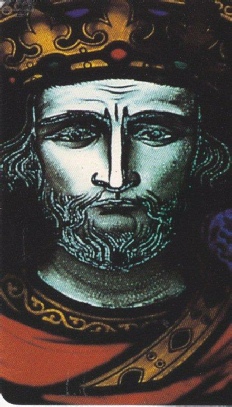
Henry III 1216 - 1272
1216
Henry III ascended the throne and reigned 56 years.
1217-21
Vth Crusade attacks Muslim Egypt but ends in failure. (1)
1221
Prior agreed with businessmen what are considered to be the earliest surviving bylaws in England.
1222
Storm blows down NW corner of Priory, rebuilt in Early English style. West Door and Prior’s Gateway remain in Romanesque style
1222
Dunstable inhabitants take part in siege of Bedford Castle. Full account in the Dunstable Annals, translation by David Preest 2013.(3)
1224
Henry III. was at Dunstable on 20 August 1224
1228
The chapel of St Mary was founded in the cemetery of the canons of Dunstable. (3)
1228-1229
Holy Roman Emperor Frederick II gains Jerusalem, Nazareth and Bethlehem on VIth crusade (1)
1229
Henry III stayed at the Priory and was asked to settle a dispute with the town
1232
The king relaxed a little and granted permission for just four tournaments to be held in England - in Dunstable, Brackley, Stamford and Blyth.
1247
King Henry III, stayed here with the Queen and their two children, Princess Margaret and Prince Edward and left gifts to be used in the church 1247
1248-1254
VIIth crusade led by Louis IXth of France attacks Egypt (1)
1250
Ten tons of Derbyshire lead put on the Refectory roof.
1252
The stables burned down at Bradbourne and a great fire at Ashbourne
1259
Dominican Friary established in Dunstable at insistence of Henry III despite much opposition from Priors. At one time Canons and Friars had a punch up.
1266
Henry III here with the Queen and Simon de Montfort the Younger (as their prisoner)
1267
Henry III here with the King of Germany
1270
Louis IXth leads VIIIth crusade against Muslim N. Africa. He dies in Tunis and crusade fails (1)
1271-1272
Prince Edward leads IXth crusade but achieves little (1)
Edward I 1272 - 1307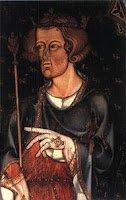
1272
Edward I, Longshanks, ascended the throne and reigned for 35 years.
1272
On the feast of All Saints, for Ralph Pirot we bound ourselves to the merchants of Cahors for 120 marks. They took our wool from the Peak at eight marks a sack until they paid the 120 marks (3)
1273
Melees were held in Dunstable in 1273, 1274, 1279, 1280, 1289, 1292, 1293 and 1301. A tournament planned for January 1290 had to be abandoned
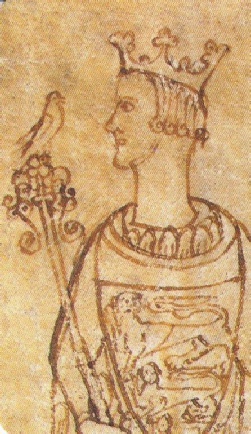
Edward I 1272 - 1307
1275
Edward I and Queen Eleanor stayed at the Priory
1276
Dispute with Edward I's falconers, who subsequently lied to the king, blaming the canons for the mayhem which ensued
1277
At the beginning of autumn, we began a large room for the use of the king, next to the prior’s room (3)
1283
Heavy rain this summer killed so many sheep in the lowlands that hereabouts we had scarce 200 left by the end of March;those in the Chiltern and Peak continued well. Against the itch, which made havock among them all over England for the last year, we anointed them successfully with stale hogg’s lard, quicksilver and verdigrease; but nothing would do against the wet (3)
1283
Mention of a clock mechanism in Dunstable Priory
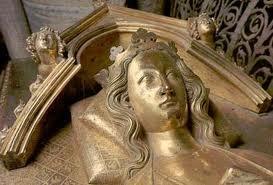
Wife of Edward 1st - Queen Eleanor's funeral cortege 5.12.1290
1290
Edward I came with the funeral cortege of Queen Eleanor. Body of Queen Eleanor, wife of Edward I, rests before the altar in Dunstable Priory on way to Westminster Abbey on night of 11-12th December. An all night mass held.
1291
Eleanor Cross erected at cross roads. Destroyed in 1643 by Parliamentary troops during the English Civil War despite Dunstable being on their side.
1292
The Annals of Dunstable record that the tournament on Ash Wednesday in 1292 was “hard fought”.(3)
1293
A knight was killed in an accident at a tournament in Dunstable and quietly buried by the canons
1305
The Prior took Roger Bradborn and five others to court for mining lead on his land to the value of 100 shillings. The Prior won. ( Derbyshire Woolley)
1307
Edward II ascended the throne and was deposed after reigning for 20 years.
1309
Tournament – staying in Dunstable for 7 – 10 days, 6 Earls, with a rough approximation of 210-220 knights, each with 10 servants and followers, ( 2,500+ people, plus spectators) plus over 3,000 horses. There must have been at least 6 respectable inns in the town at this time. For the list of men who took part, see tournaments.
1324
The lady Chapel rebuilt. (scene of the Court of Annulment).
1326
Queen Isabella passed through with her army on the way to attack the supporters of Edward II
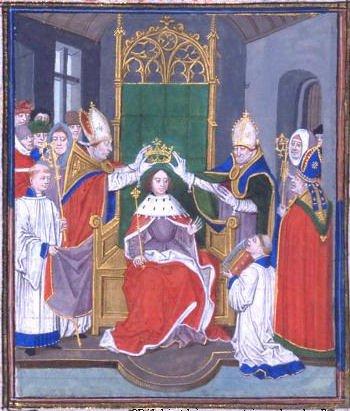
Edward III Coronation
1327
Edward III ascended the throne and reigned for 50 years.
1329
Edward III here for a tournament
1337-1453
The Hundred Years War. An intermittent struggle between England and France.
1341
Edward III here for a Tournament at Dunstable, held in honour of Sir Nigel Loring, Lord of the manor of Chalgrave.
Edward III, Queen Philippa and Edward the Black Prince attend.
1342
Last recorded joust/tournament in Dunstable.
1348
King Edward III form the Chivalric Order of the Most Noble Order of the Garter (1)
1349
In the plague time the townsmen made themselves a bell, and called it Mary; and Prior Roger lent them lead to cover it.
1356
The English defeat the French at Poitiers (1)
Richard II 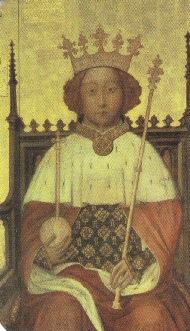 1377-1399
1377-1399
1377
Richard II ascended the throne and was deposed after 22 years.
1381
Peasants' Revolt. Thomas Hobbes and other residents extracted a new Charter from prior Marshall, under duress. This was later rescinded by Richard II.
1383
John of Toddington inherited; 8 messuages and 7 virgates of land held of the prior of Dunstable by service of maintaining the prior with his men, horses and hounds twice a year for as long as the prior shall be please to stay there with his men etc on his way from Dunstable to a certain manor of his in the county of Derby and on his way back to Dunstable and a watermill held of the same prior by the same service.' Inquisitions
1390
John (of) Dunstaple born about this time, world famous musician and mathematician. He composed the music celebrating Henry V’s victory at Agincourt in 1415. Died 1453/8. He wrote theses on mathematics, astronomy and astrology.
1392
An agreement (following a bitter argument) between the town and the Prior was made, following which that part of the church we have left today was recognised as the Parish Church of Dunstable. It is only due to this agreement that Henry VIII didn't knock it down.
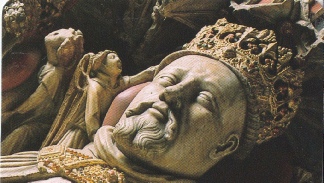 Henry IV 1399 - 1411
Henry IV 1399 - 1411
1399
Henry IV, first Lancastrian king, usurper, ascended the throne and reigned for 14 years.
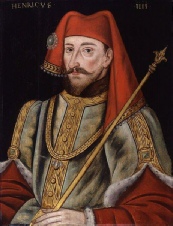
1400
The tilt or central barrier on the tournament lists commonly used from around this date (1)
Henry V 1413 - 1422 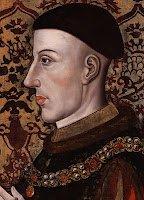
1413
Henry V ascended the throne and reigned 9 years.
1422
Henry VI ascended throne. He reigned from 1422-61 and 1470-1471, 40 years.
1437
Henry VI went through Dunstable on 20th July
1442
A Fraternity of businessmen was formed in the 15th century. They were members of the London Wool Staplers Company and bought a licence from Henry VI in 1442 to form a brotherhood dedicated to St John the Baptist,based at St Peter’s Church. Dunstable Fraternity Registers for most of these years 1440 to 1540,have survived. 1 of only 4 known surviving sets. Other Fraternity ‘treasures’ such as Fayrey brasses and funeral pall now in V & A and British Museums respectively.
1444
A dispute between the canons and the friars, at the Friary, during which one friar was thrown into the pond.
1450
Building of present bell tower at Priory.
1450
Henry VI went through Dunstable on 23rd July
1451
Henry VI went through Dunstable on 14th September
1453
Death of John Dunstable
1455- 1485
The Wars of the Roses.
1455 and 1461
Two encampments of the Lancastrian forces under Margaret of Anjou (formidable wife of King Henry VI) en route to the two Battles of St Albans. Told to "live off the land", they caused mayhem in the town - and short shrift was given to the Yorkist supporters.
It is possible - but not proven - that the Dunstable Swan Jewel ( British Museum) is a left over from the second battle.
Henry VI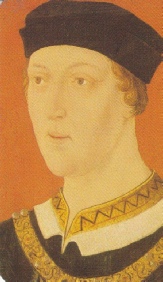
1457
King Henry VI and Queen Margaret visit Dunstable
1459
King Henry VI. visited Dunstable and issued a proclamation to the townspeople
1460
Henry VI went through Dunstable on 24th and 25th February.
1461
February 16th in the evening, the Queen, Margaret of Anjou, with her Lancastrian forces ‘surprised’ Dunstable, 15,000 undisciplined troops against 200 men led by the butcher, on their way to 2nd Battle of St. Albans
1461
February 19th Margaret of Anjou wins the 2nd battle of St. Albans, secures the release of Henry VI and they both return north with the army through Dunstable.
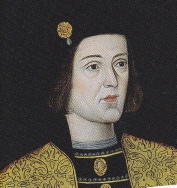
Edward IV 1461 - 1470
1461
Edward IV ascended the throne and reigned from 1461-1470 and 1471-1483, 21 years.
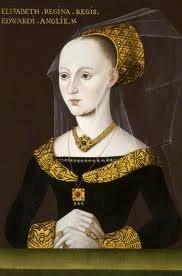
Elizabeth Woodville wife of Edward IV
1480-90?
The Priory Church roof is lowered. A great engineering feat paid for by the Dunstable Fraternity.

Edward V
1483
Edward V ascended the throne and reigned for two months.
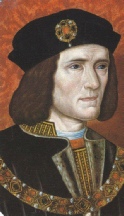
Richard III
1483
Richard III, usurper, ascended the throne and reigned for 2 years.
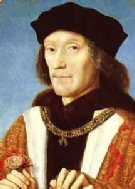
Henry VII
1485
Henry VII, first Tudor king, ascended the throne and reigned for 24 years.
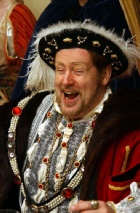
Henry VII
1509
Henry VIII ascended the throne on 21st April, aged17years and reigned for 38 years.
1509
Henry VIII married Catherine of Aragon on 11th June
1520
Field of the Cloth of Gold
1526
Henry VIII visited with Queen Catherine
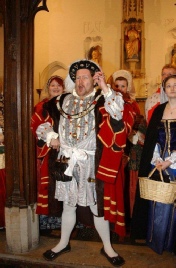
1533
10th - 23rd May the Court of Annulment at Dunstable to decide the ‘King’s great and weightie matter’ – to free him from Catherine of Aragon. Henry VIII’s bishops met in the Lady Chapel of Dunstable Priory. The annulment of the marriage resulted in the break from Rome and the beginning of the Reformation.
1534
Henry VIII imposed a new 10% income tax on all church lands and benefits.
1535
To ensure the new 10% tax was correct, Henry VIII had an assessment made of the church’s property and income across England; - the Valor Ecclesiasticus.
1530s
George Cavendish was living at Kingsbury. He was Wolsey’s biographer. Perhaps the first biography ever written.
1536
The Court of Augmentation was founded to ensure the crown received all the land, properties and income of the monasteries.
1536
The Dominican Friary surrendered
1537 and 1540
Henry VIII stayed at the White Horse Inn
1540
Dissolution of Priory, surrendered on 20th January
1541
Henry VIII stayed at the White Horse Inn
1540s
Henry VIII had a plan for Dunstable to be a Bishopric and convert the church into a cathedral, The plan failed and the Prior and Canons were pensioned off.
1555
Marian Screen installed in the Priory Church
1561
Death at Dunstable of Gervase Markham the last Prior.
References
1 Knights & Crusades, Charles Phillips
2 . A Collection of Charters, Section Land and People, note 277, p 1077-8
3. Dunstable Annals, David Preest 2013, Boydell and Brewer
4. Charters of Dunstable Priory, Beds Historical Record Society, Vol. X
| Archaeology |
| Audio Guides |
| Education |
| Exhibitions |
| Events 2013 |
| Physic Garden |
| Priory History |
| Priory Churches / Lands |
| Town History |
| Virtual Tour |
| Website |
| Archaeology |
| Charters & Bylaws |
| Eleanor Cross |
| Famous People |
| The Fraternity |
| Friary |
| Guided Tours |
| History |
| Inns |
| Dunstable Treasures |
| Kingsbury |
| Middle Row |
| Royal Visits |
| Sheep & Wool Trade |
| The Town |
| Friary Archaeology |
| Bone Study |
| Friary |
| Annals Charters Valor Ecc |
| Archaeology |
| Churches and Lands |
| Guided Visits |
| Audio Guides |
| History |
| Monastic Life |
| Virtual Tour |
| The Augustinian Priory |
| The Canons Route |
| Bedfordshire |
| Buckingham |
| Derbyshire |
| Nothamptonshire |
| Hertfordshire |
| Leicestershire |
| Oxon |
| Priors |
| Annulment |
| History |
| Archives |
| Book Sales & Shop |
| Exhibitions |
| Guided Walks |
| Heritage Talks |
| Physic Gardens |
| Schools |
| Tourist Information Centre |
| Tea-room |
| Visits |
| Priory House Heritage Centre |
| Education |
| Knight |
| Search Results |